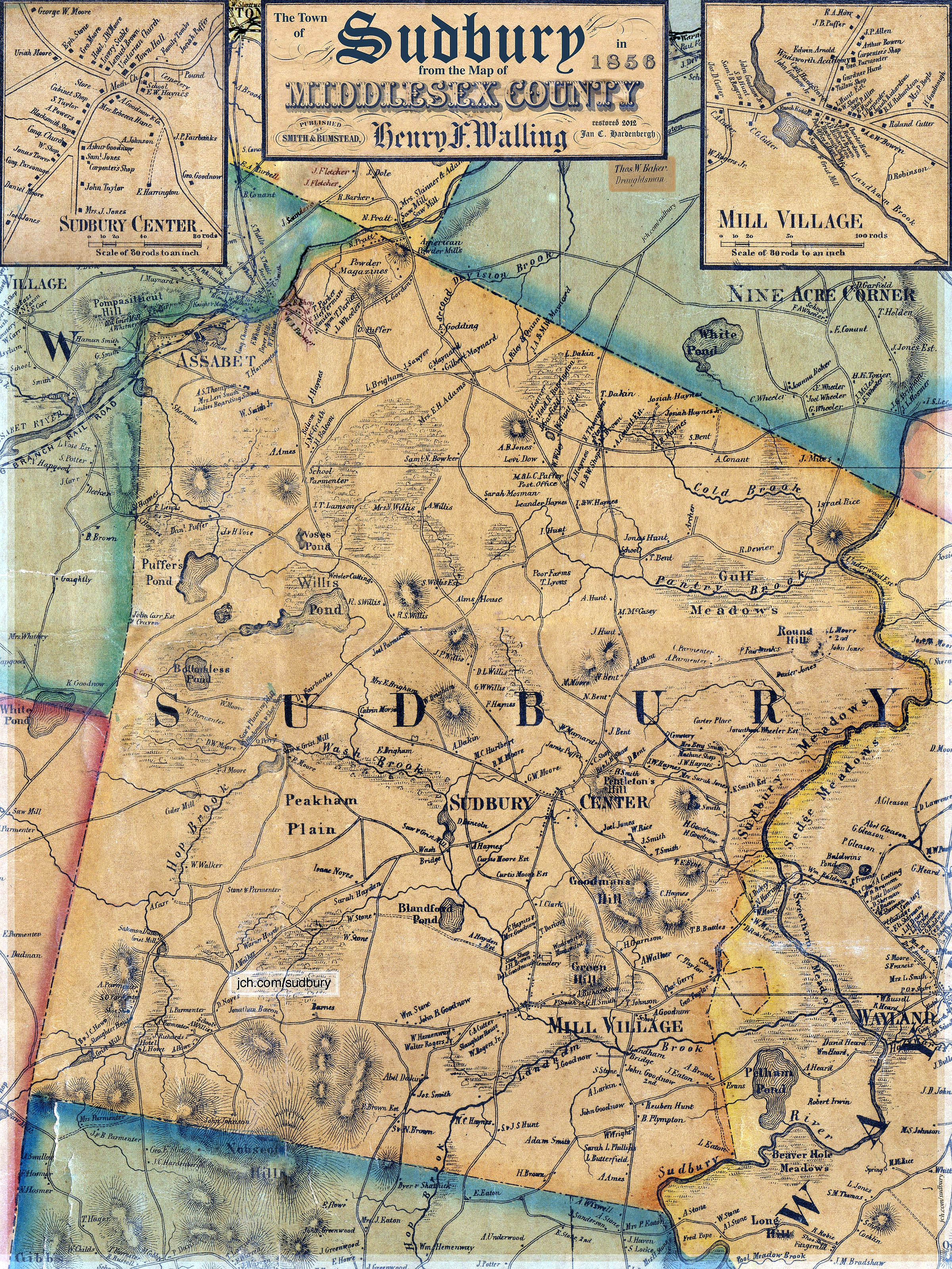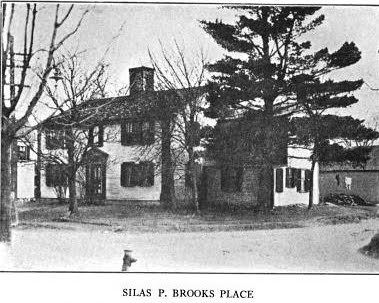|
Old Marlboro Road
Old Marlboro Road (also known as Old Marlborough Road) is a historic road and the name of a poem about the road by Henry David Thoreau, published in his work, ''Walking''. Old Marlboro Road currently runs through Concord, Sudbury, and Maynard, Massachusetts, United States. History The road likely originated as an Indian path, being the "shortest course through the domain of Tantamous (Maynard) to Occogoogansett (Marlboro)." Colonists settled along the road in the seventeenth century. During the Revolutionary War, ammunition wagons traveled along Old Marlboro/Concord Road to provide George Washington arms for his defense of Trenton. In the nineteenth century, Transcendentalist Henry David Thoreau lived near the disused road in Concord, and frequently walked along it, before writing a poem entitled "The Old Marlborough Road." Parts of the route exist as road anew, from Concord, near Emerson Hospital, into Sudbury and then Maynard, where it terminates at the Assabet River National Wi ... [...More Info...] [...Related Items...] OR: [Wikipedia] [Google] [Baidu] |
Henry David Thoreau
Henry David Thoreau (July 12, 1817May 6, 1862) was an American naturalist, essayist, poet, and philosopher. A leading Transcendentalism, transcendentalist, he is best known for his book ''Walden'', a reflection upon simple living in natural surroundings, and his essay "Civil Disobedience (Thoreau), Civil Disobedience" (originally published as "Resistance to Civil Government"), an argument for disobedience to an unjust state. Thoreau's books, articles, essays, journals, and poetry amount to more than 20 volumes. Among his lasting contributions are his nature writing, writings on natural history and philosophy, in which he anticipated the methods and findings of ecology and environmental history, two sources of modern-day environmentalism. His literary language, literary style interweaves close observation of nature, personal experience, pointed rhetoric, symbolic meanings, and historical lore, while displaying a poetic sensibility, philosophical Asceticism, austerity, and attent ... [...More Info...] [...Related Items...] OR: [Wikipedia] [Google] [Baidu] |
Walking (Thoreau)
''Walking'', or sometimes referred to as "The Wild", is a lecture by Henry David Thoreau first delivered at the Concord Lyceum on April 23, 1851. It was written between 1851 and 1860, but parts were extracted from his earlier journals. Thoreau read the piece a total of ten times, more than any other of his lectures. "Walking" was first published as an essay in the ''Atlantic Monthly'' after his death in 1862. Transcendentalism in Walking/Form "Walking" is a transcendental essay that analyzes the relationship between man and nature, trying to find a balance between society and our raw animal nature. I would not have every man nor every part of a man cultivated, any more than I would have every acre of earth cultivated: part will be tillage, but the greater part will be meadow and forest. Part of Nature I wish to speak a word for Nature, for absolute freedom and wildness, as contrasted with a freedom and culture merely civil, -to regard man as an inhabitant, or a part and par ... [...More Info...] [...Related Items...] OR: [Wikipedia] [Google] [Baidu] |
Concord, Massachusetts
Concord () is a town in Middlesex County, Massachusetts, in the United States. At the 2020 census, the town population was 18,491. The United States Census Bureau considers Concord part of Greater Boston. The town center is near where the confluence of the Sudbury and Assabet rivers forms the Concord River. The area that became the town of Concord was originally known as Musketaquid, an Algonquian word for "grassy plain." Concord was established in 1635 by a group of English settlers; by 1775, the population had grown to 1,400. As dissension between colonists in North America and the British crown intensified, 700 troops were sent to confiscate militia ordnance stored at Concord on April 19, 1775.Chidsey, p. 6. This is the total size of Smith's force. The ensuing conflict, the battles of Lexington and Concord, were the incidents (including the shot heard round the world) that triggered the American Revolutionary War. A rich literary community developed in Concord during the ... [...More Info...] [...Related Items...] OR: [Wikipedia] [Google] [Baidu] |
Sudbury, Massachusetts
Sudbury is a town in Middlesex County, Massachusetts, United States. At the 2020 census, it had a population of 18,934. The town, located in Greater Boston's MetroWest region, has a rich colonial history. History Incorporated in 1639, the boundaries of Sudbury included (by 1653) what is now Wayland (which split off in 1780, initially as East Sudbury), and parts of present day Framingham, Marlborough, Stow and Maynard (the latter town splitting off in 1871). Nipmuc Indians lived in what is now Sudbury, including Tantamous, a medicine man, and his son Peter Jethro, who deeded a large parcel of land to Sudbury for settlement in 1684.Gutteridge, William H. (1921)''A Brief History of the Town of Maynard, Massachusetts'' Maynard, MA: Town of Maynard, p. 13-16 The original town center and meetinghouse were located near the Sudbury River at what is now known as Wayland's North Cemetery. For the residents on the west side of the river, it was a treacherous passage in the winter and ... [...More Info...] [...Related Items...] OR: [Wikipedia] [Google] [Baidu] |
Maynard, Massachusetts
Maynard is a town in Middlesex County, Massachusetts, United States. The town is located 22 miles west of Boston, in the MetroWest and Greater Boston region of Massachusetts and borders Acton, Concord, Stow and Sudbury. The town's population was 10,746 as of the 2020 United States Census. Maynard is located on the Assabet River, a tributary of the Concord River. A large part of the Assabet River National Wildlife Refuge is located within the town, and the Assabet River Rail Trail connects the Refuge and downtown Maynard to the South Acton commuter rail station. Historic downtown Maynard is home to many shops, restaurants, galleries, a movie theater, and the former Assabet Woolen Mill, which produced wool fabrics from 1846 to 1950, including cloth for Union Army uniforms during the Civil War. Maynard was the headquarters for Digital Equipment Corporation from 1957 to 1998. Owners of the former mill complex currently lease space to office and light-industry businesses. History ... [...More Info...] [...Related Items...] OR: [Wikipedia] [Google] [Baidu] |
Tantamous
Tantamous (also known as Old Jethro or John Jethro) (c. 1580–1676) was a well-known Native American Nipmuc leader in seventeenth century Massachusetts. Tantamous was a powwow ( healer and spiritual leader) who lived near the Assabet River,Barry, William, ''A History of Framingham, Massachusetts'' (Boston: James Munroe and Company, 1847) later in Nobscot (now Framingham). Tantamous "...may have gotten his English name for his good advice." Early life According to one source " his earlier years it is supposed antamouslived at Isabaeth, the country about the Assabet River, now Maynard." Around 1635 Tantamous and/or his son Peter Jethro was present with a group of Native Americans to witness the sale of what is now downtown Concord to local colonists. In 1651, Tantamous transferred land in what is now Maynard to Herman Garrett, a resident of Concord, by defaulting on a mortgaged mare and colt. In 1659, John Smith of Charlestown unsuccessfully requested the Massachusetts Gener ... [...More Info...] [...Related Items...] OR: [Wikipedia] [Google] [Baidu] |
American Revolutionary War
The American Revolutionary War (April 19, 1775 – September 3, 1783), also known as the Revolutionary War or American War of Independence, was a major war of the American Revolution. Widely considered as the war that secured the independence of the United States, fighting began on April 19, 1775, followed by the Lee Resolution on July 2, 1776, and the Declaration of Independence on July 4, 1776. The American Patriots were supported by the Kingdom of France and, to a lesser extent, the Dutch Republic and the Spanish Empire, in a conflict taking place in North America, the Caribbean, and the Atlantic Ocean. Established by royal charter in the 17th and 18th centuries, the American colonies were largely autonomous in domestic affairs and commercially prosperous, trading with Britain and its Caribbean colonies, as well as other European powers via their Caribbean entrepôts. After British victory over the French in the Seven Years' War in 1763, tensions between the motherland and he ... [...More Info...] [...Related Items...] OR: [Wikipedia] [Google] [Baidu] |
George Washington
George Washington (February 22, 1732, 1799) was an American military officer, statesman, and Founding Father who served as the first president of the United States from 1789 to 1797. Appointed by the Continental Congress as commander of the Continental Army, Washington led the Patriot forces to victory in the American Revolutionary War and served as the president of the Constitutional Convention of 1787, which created the Constitution of the United States and the American federal government. Washington has been called the " Father of his Country" for his manifold leadership in the formative days of the country. Washington's first public office was serving as the official surveyor of Culpeper County, Virginia, from 1749 to 1750. Subsequently, he received his first military training (as well as a command with the Virginia Regiment) during the French and Indian War. He was later elected to the Virginia House of Burgesses and was named a delegate to the Continental Congress ... [...More Info...] [...Related Items...] OR: [Wikipedia] [Google] [Baidu] |
The Old Marlborough Road
"The Old Marlborough Road" is a poem written by Trascendentalist philosopher Henry David Thoreau in 1850. Thoreau lived near the disused Old Marlboro Road in Concord, Massachusetts, and frequently walked along it, which inspired him to write the poem. It first appeared as a journal entry in 1850; it was extensively revised before being incorporated into ''Walking Walking (also known as ambulation) is one of the main gaits of terrestrial locomotion among legged animals. Walking is typically slower than running and other gaits. Walking is defined by an 'inverted pendulum' gait in which the body vaults o ...,'' published posthumously in 1862. References 1850 poems Works by Henry David Thoreau American poems {{1850s-poem-stub ... [...More Info...] [...Related Items...] OR: [Wikipedia] [Google] [Baidu] |
Assabet River National Wildlife Refuge
The Assabet River National Wildlife Refuge (ARNWR; formerly referred to as the U.S. Army's Fort Devens-Sudbury Training Annex) is a protected National Wildlife Refuge located approximately west of Boston and west of the Eastern Massachusetts National Wildlife Refuge Complex Headquarters, along the Assabet River. It is located in portions of the towns of Hudson, Maynard, Stow and Sudbury. The Assabet River National Wildlife Refuge consists of two separate pieces of land. The larger northern section is just north of Hudson Road, extending north to the Assabet River. The southern section is located to the south of Hudson Road. There is a visitor center located in the northern section on Winterberry Way. Wildlife and habitat The refuge contains a diverse mixture of pine and hardwood forest, old fields, and wetland habitats, including vernal pools. The refuge is an "important feeding and breeding areas for migratory birds and other wildlife." The rare Blanding's turtle species is ... [...More Info...] [...Related Items...] OR: [Wikipedia] [Google] [Baidu] |
Roads In Massachusetts
A road is a linear way for the conveyance of traffic that mostly has an improved surface for use by vehicles (motorized and non-motorized) and pedestrians. Unlike streets, the main function of roads is transportation. There are many types of roads, including parkways, avenues, controlled-access highways (freeways, motorways, and expressways), tollways, interstates, highways, thoroughfares, and local roads. The primary features of roads include lanes, sidewalks (pavement), roadways (carriageways), medians, shoulders, verges, bike paths (cycle paths), and shared-use paths. Definitions Historically many roads were simply recognizable routes without any formal construction or some maintenance. The Organization for Economic Co-operation and Development (OECD) defines a road as "a line of communication (travelled way) using a stabilized base other than rails or air strips open to public traffic, primarily for the use of road motor vehicles running on their own wheels", which i ... [...More Info...] [...Related Items...] OR: [Wikipedia] [Google] [Baidu] |










